
展覽海報
策展人:巫鴻
展覽日期:2016年11月4日—12月11日
展覽地點:北京民生現代美術館 一層主展廳
地址:中國北京市朝陽區酒仙橋北路9號 恒通國際創新園C7
開 幕 式 :2016年11月4日(星期五) 下午3時
開幕演出:2016年11月4日(星期五) 下午4時
演出團隊:小河(聲音設計、演奏)、文文(統籌)、熊熊作業(聲音設計、演奏)、潘君杰(聲音設計、演奏)
鄔建安的想象力總在幾個維度上同時進行,他的作品也總在幾個維度上同時刺激和擴展人們的藝術想象。他游走于文字和圖像之間,在抽象與具象之上又加上一個敘事維度。他擺脫單純的視覺和觀看,因此引入了聲音和演出。他馳騁于古今之間,把當下的人們在瞬息間帶往詭譎奇邈的洪荒時代。他跨越媒材和風格:繪畫、雕塑、剪紙、裝置提供給他多樣的語匯,但同時激起跨界、綜合、打亂、超越的欲望。
“《征兆》是神秘的:一些奇異現象出現了,預示著即將發生的巨大事件,或是天降災禍或是朝代變換,甚至是人類和地球的終結。‘征兆’的思維邏輯超越文化和地域的分野,隱藏在古人的科學推理和政治哲學之中。但無論怎樣它總是對未知和對將來的想象。在這一點上征兆與藝術——特別是與當代藝術有著值得思考的內在關系,因為藝術總是有關想象的,而真正的當代藝術總是為了通向未知和未來而創作。”
???????????????????????????????????????????????????????????????????????????????????????????????????? ——巫鴻
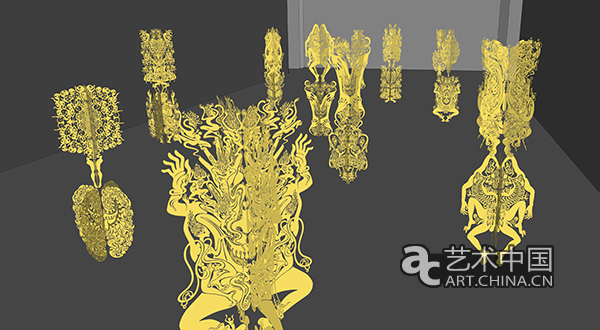
《白日夢的樹林》(示意圖),鄔建安,黃銅雕刻,尺寸不一,2016..
北京民生現代美術館將于2016年11月4日至12月11日呈現藝術家鄔建安的最新個人藝術作品展——《征兆:鄔建安新作展》。本次展覽由中國民生銀行和北京民生現代美術館聯合主辦,前波畫廊協辦,由著名藝術史學家、批評家、芝加哥大學教授巫鴻擔任策展人。
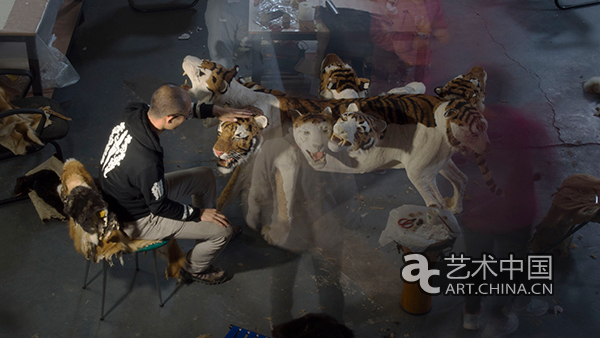
鄔建安與《征兆》
在藝術創作的方式上,鄔建安一直通過綜合性的材料和形式語言探索,從多個層面建構傳統與當代的轉換與融合。近年來,他專注于以當代的視角對經中西方經典文學、宗教和哲學文本進行重新解讀,發掘其中潛藏的有關當代社會和文化現實的問題,建立其與個體精神世界的聯系,形成極富風格性和表現力的藝術表達。 策展人巫鴻在本次展覽的前言中寫道:“鄔建安的想象力總在幾個維度上同時進行,他的作品也總在幾個維度上同時刺激和擴展人們的藝術想象。他游走于文字和圖像之間,在抽象與具象之上又加上一個敘事維度。他擺脫單純的視覺和觀看,因此引入了聲音和演出。他馳騁于古今之間,把當下的人們在瞬息間帶往詭譎奇邈的洪荒時代。他跨越媒材和風格:繪畫、雕塑、剪紙、裝置提供給他多樣的語匯,但同時激起跨界、綜合、打亂、超越的欲望。”
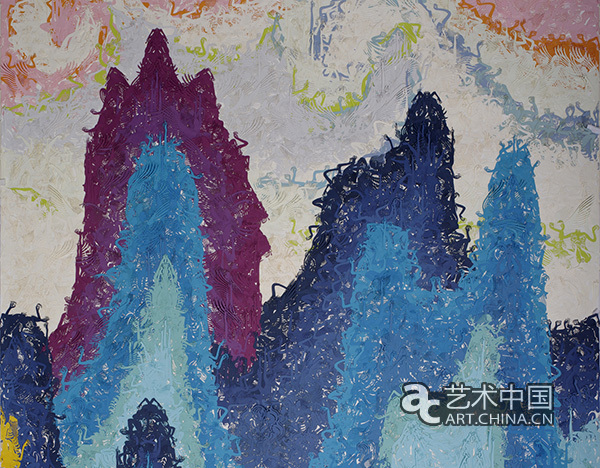
《大河的誕生之南面》(局部),鄔建安,背絹彩色剪紙拼貼
此次展覽以“征兆”為題,將展出藝術家鄔建安的四組不同形態與媒介的藝術作品:從歷時4年所作的“標志性”的大型彩色剪紙拼貼作品《大河的誕生》,到從內容上與剪紙作品發生互文關系的裝置作品《三王冢》;從運用黃銅鏤刻的語言對10年前的作品進行“再創造”的《白日夢的樹林》,再到最新的“跨界”藝術實驗——由9件仿真動物標本組成的互動聲音裝置藝術作品《征兆》,展覽將通過建構一種復合性的視觀,一方面呈現藝術家圍繞中西方神話和社會現實中有關“征兆”的觀念與現象所進行的“主題闡釋”,另一方面也是對鄔建安十年來藝術實踐經歷的一次“隱性”回顧和線索梳理,為學界和公眾了解他的藝術思考理路和創作的方法論提供一條新的路徑。

《白日夢——靜觀內景》鄔建安-夾宣鏤刻剪紙-2003-2006
“征兆是一種非常特別的東西,它們可以被理解為‘天人感應’的重要訊息,也可以被認定為推動權力運作和制度革新的有力工具;它們既是對未來的預警或祝福,也是集體意愿凝聚幻化的現實景觀。在我們國家悠久的歷史歲月之中,征兆的故事此起彼伏,數不勝數,它們的生命力寄存在我們的血脈里,在今人執著的念想或不經意的呼喚中閃爍、現身,成為眼前的實在,并將對似乎寫定的未來構成顛覆的威脅,或者在未來身上撕扯出一條分叉的歧路。征兆是人的選擇。” ——鄔建安
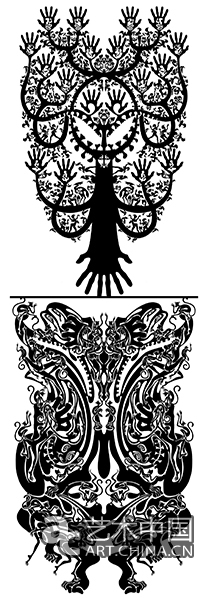
《白日夢的樹林》之《楠》(設計圖),鄔建安,2006—2016年
此外,在策展人巫鴻看來,本次展覽也“提供了一個連接神話世界與當代思考的契機”:“四件作品的主題在中國文化和藝術中都有著數千年的歷史根源:這里有“與天地爭神”的無頭巨人刑天,有《山海經》中身發異聲的奇形動物,有“眉間尺”傳說的慘烈結局,也有由漢代“搖錢樹”化出的“白日夢樹林”。猶如文化的基因,這些故事與形象在這個展覽中被鄔建安的當代藝術作品再次激活。”

《大河的誕生之山藏》,鄔建安,背絹彩色剪紙拼貼,250x180cm
開幕當日,實驗音樂制作人小河將與他的團隊在展廳舉行名為《兆》的現場音樂演出,該作品為小河團隊受邀為本次展覽專門制作,使用的樂器均為鄔建安的動物標本樂器作品。
?關于藝術家
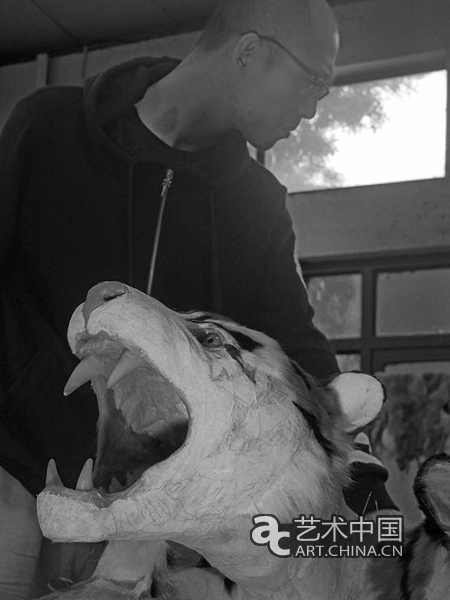
藝術家鄔建安
??? 鄔建安,1980 年生于北京。 2005 年畢業于中央美術學院,獲碩士學位并留校任教,現為中央美術學院實驗藝術學院副教授,碩士生導師,中國美協實驗藝委會委員,文化部恭王府中華傳統技藝研究與保護中心研究員。他的作品曾先后在福岡亞洲藝術博物館、林肯郡博物館、中央美術學院美術館、華盛頓肯尼迪藝術中心、恭王府、波士頓美術館、紐約大都會藝術博物館等機構展出,并在北京、上海、紐約、新加坡等地舉辦多次個人藝術作品展。
關于策展人

Omens: Recent Works by Wu Jian’an?Curator: Wu Hung?Exhibition Date: November 4 – December 11, 2016 Venue: Beijing Minsheng Art Museum, First Floor Location:Universal Creative Park C7 No.9 Jiuxianqiao North Road, Chaoyang District, Beijing, China
Opening Reception: November 4, 2016, 3:00 pm Opening Performace: November 4, 2016, 4:00 pm Performance Group: Xiao He (Sound design, performer), Wen Wen(co-ordinator), Xiong Xiong Work (Sound design, performer), Wei Junjie (Sound design, performer)
? Beijing Minsheng Art Museum presents: Omens: Recent Works by Wu Jian’an from November 4 to December 11, 2016. Curated by Wu Hung, this is the first comprehensive solo museum exhibition of the artist’s work, and is co-sponsored by China Minsheng Bank and Minsheng Art Museum, and assisted by Chambers Fine Art.
Wu Jian’an was born in 1980 in Beijing, graduated with MFA from Central Academy of Fine Arts in 2005 and became a lecturer at CAFA. Currently he is the Associate Professor and graduate student supervisor in the Department of Experimental Art at CAFA. His work has been exhibited at numerous institutions including the Fukuoka Asian Art Museum, Museum of Lincolnshire Life, China Central Academy of Fine Arts, John F. Kennedy Center for the Performing Arts, Prince Gong’s Mansion, Museum of Fine Arts, Boston, and The Metropolitan Museum of Art in New York.
In Wu Jian’an’s early works, he used traditional Chinese paper-cut techniques to illustrate mythical and philosophical concepts from both the East and West with his own imaginative, contemporary style. This exhibition not only presents works made using this medium and style, but also shows more recent works with expanded themes and materials. Wu Hung states that: “Wu Jian’an’s imagination has always operated simultaneously in multiple dimensions. Likewise, his works simultaneously expand the viewer’s artistic imagination in various directions. He travels between words and images while adding a layer of storytelling above figuration and abstraction. He introduces sound and performance to break away from mere visuals and viewing. He freely traverses temporal divides, instantaneously taking viewers from today’s world back to mysterious primeval times. His art spans various media and styles: painting, sculpture, paper cut, and installation, all of which provide him with a varied vocabulary yet also arouse his desire to cross boundaries – to integrate, transgress and disarrange.”
In describing the overall theme of the exhibition, Wu Hung states “Omens are mythical. They are occurrences of strange phenomena that portend major events, either natural disaster or dynastic change, or even the end of humankind and the earth. The concept and logic of omens transcend cultural and geographical spheres; their language is that of ancient scientific theory and political philosophy. In all such cases, omens involve the imagination of the unknown and the future. From this perspective, it is worth considering the relationship between omens and art, especially contemporary art, because art is always related to imagination, and true contemporary art always aims to create a trajectory to the unknown and the future.”
Interpreted in this way, this exhibition establishes a unique link between contemporary thinking and the mythical world. Each of the four themes presented here are rooted in ancient Chinese legends: the headless giant Xingtian who fought against the Supreme Divinity, grotesque animals that make strange sounds from the Classic of Mountains and Seas, the catastrophic ending of the boy assassin Mei Jianchi, and the Money Trees of the Han dynasty that have inspired Wu Jian’an’s Daydream Forest. Like cultural genes, these stories and characters have been passed down through history and reborn in Wu’s art.




